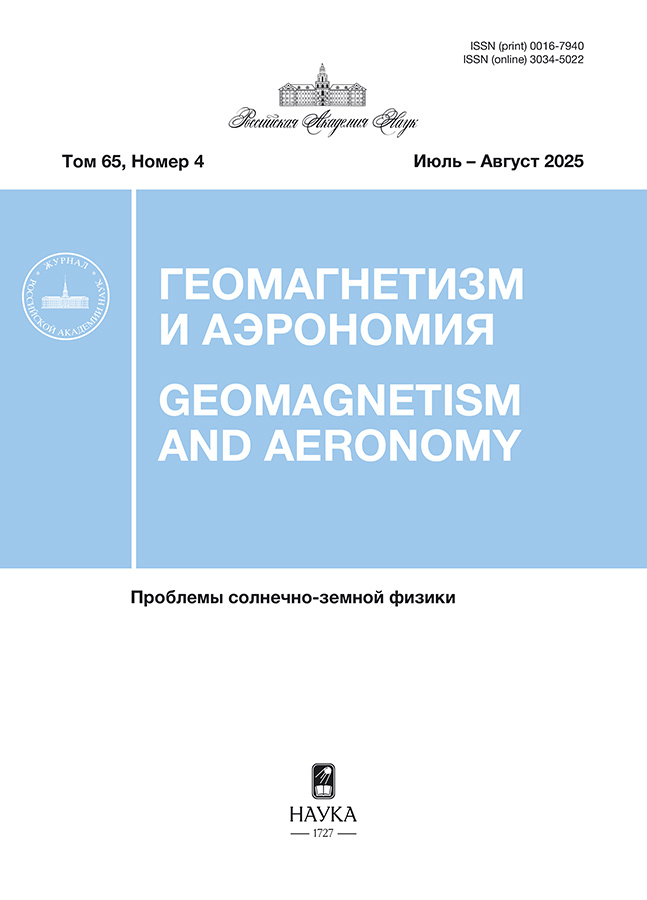Changes in the critical frequency foF2 and their interpretation
- Авторлар: Danilov A.D.1, Berbeneva N.A.2
-
Мекемелер:
- Fedorov Institute of Applied Geophysics
- Lomonosov Moscow State University
- Шығарылым: Том 65, № 4 (2025)
- Беттер: 500-512
- Бөлім: Articles
- URL: https://kazanmedjournal.ru/0016-7940/article/view/688302
- DOI: https://doi.org/10.31857/S0016794025040083
- EDN: https://elibrary.ru/EYACTR
- ID: 688302
Дәйексөз келтіру
Аннотация
The results of the recent publication by Qiann and Mursula who have found an increase with time in the ratio of the modelled and observed values of the thermospheric density at satellite heights are considered. It is assumed that that increase is related to the existence of the negative trend in the density that is not described by the model properly. To confirm this concept, the change with time in the modelled and observed values of the F2-layer critical frequency foF2, foF2(mod)/foF2(obs) based on the observations at the Northern and Southern hemisphere stations is considered. It is shown that the same increase is observed for this ratio as for the ratio of densities. It is found that the rate of this increase in foF2 correlate well with the foF2 trends (in MHz/year) in winter months when the negative trends are small. In the winter months when the foF2 trends are small, there is almost no foF2(mod)/foF2(obs) increase. All that allows us to assume that the results of Qiann and Mursula show that the model incompletely describes the negative trends in the density.
Толық мәтін
Авторлар туралы
A. Danilov
Fedorov Institute of Applied Geophysics
Хат алмасуға жауапты Автор.
Email: adanilov99@mail.ru
Ресей, Moscow
N. Berbeneva
Lomonosov Moscow State University
Email: adanilov99@mail.ru
Physics Faculty
Ресей, MoscowӘдебиет тізімі
- Данилов А.Д., Константинова А.В., Бербенева Н.А. Тренды критической частоты foF2 по данным станций Северного и Южного полушарий // Геомагнетизм и аэрономия. Т. 64. № 3. С. 387–400. 2024. https://doi.org/10.31857/S0016794024030059
- Данилов А.Д., Константинова А.В., Рябухин И А. Тренды параметров слоя F2 по данным ст. Свердловск (Арти) // Геомагнетизм и аэрономия Т. 65. № 4. С. 480–497. 2025.
- Cnossen I., Emmert J.T. Garcia R.R., Elias A.G., Mlynczak M.G., Zhang Sh.R. A review of global long–term changes in the mesosphere, thermosphere and ionosphere: a starting point for inclusion in (semi–)empirical models // Adv. Space Res. V. 74. № 11. P. 5991–6011. 2024. https://doi.org/10.1016/j.asr.2024.10.005
- Danilov A.D., Ryabukhin I.A. Trends of the F2-layer parameters based on Sverdlovsk (Arti) station data // Adv. Space Res. 2025. https://doi.org/10.1016/j.asr.2024.12.078
- Emmert J.T., Dhadly M.S., Segerman A.M. A globally averaged thermospheric density data set derived from two-line orbital element sets and special perturbations state vectors // J. Geophys. Res. – Space. V. 126. № 8. ID e2021JA029455. 2021. https://doi.org/10.1029/2021JA029455
- Laštovička J. Progress in investigating long–term trends in the mesosphere, thermosphere, and ionosphere // Atmos. Chem. Phys. V. 23. № 10. P. 5783–5800. 2023. https://doi.org/10.5194/acp-23-5783-2023
- Qian L., Mursula K. Evaluating F10.7 and F30 radio fluxes as long-term solar proxies of energy deposition in the thermosphere // Ann. Gophys. Discuss. 2024. https://doi.org/10.5194/angeo-2024-23
- Solomon S., Liu H., Marsh D., McInerney J., Qian L., Vitt F. Whole atmosphere simulation of anthropogenic climate change / Paper presented at the 10th Workshop on Long-Term Changes and Trends in the Atmosphere. May 14–18, 2018. Hefei, China. 2018.
Қосымша файлдар
















